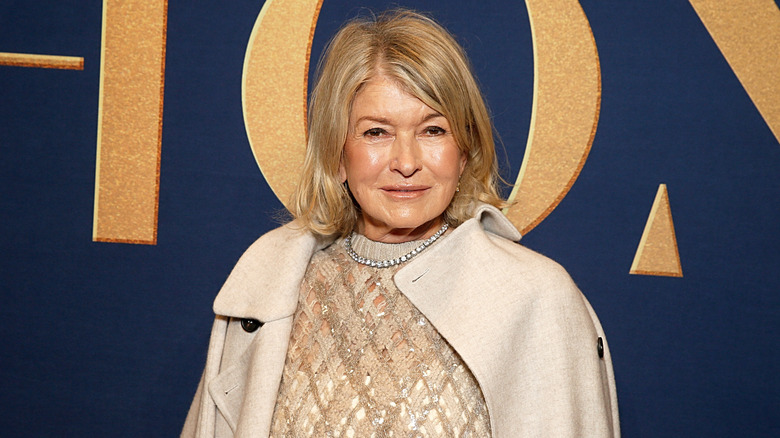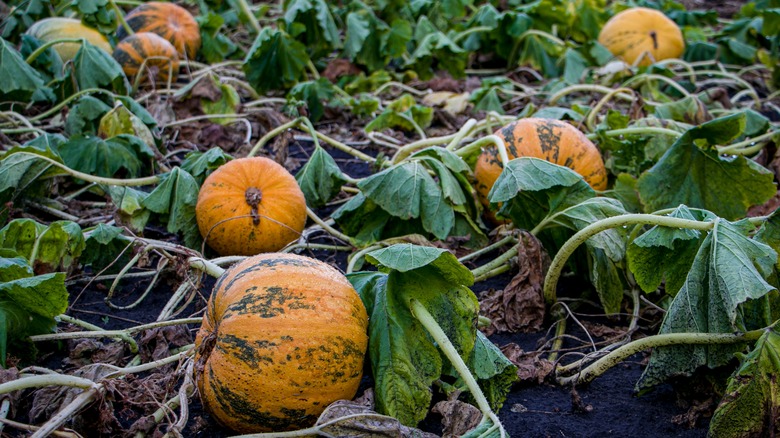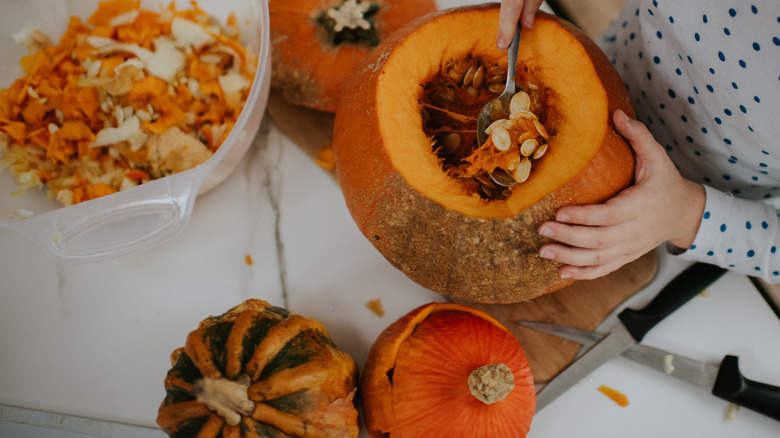Martha Stewart's Expert Advice For Growing The Perfect Pumpkins
Are you envious of the beautiful pumpkins on everyone's porches this year and want to know the best way to grow your own? Martha Stewart may have some answers for you. In a recent Instagram post, she talked about how she grew her pumpkin crop differently this year. Instead of her usual practice of planting in a wide open space, Stewart talks about how she grew her pumpkins around the perimeter of the garden. To see if this would work for the home gardener, House Digest spoke with Colleen Vanderlinden, author and garden writer, in an exclusive interview to learn more about Stewart's advice and pumpkin growing.
We asked Vanderlinden about the benefits and possible disadvantages of growing pumpkins this way. "Growing pumpkins around the perimeter of a garden is a good idea. It allows the vines to spread without invading the space of other vegetables you're trying to grow," Vanderlinden said. "Pumpkin vines can become huge, so if you grow them in your vegetable garden, the vines can also start creeping into paths and make it harder to work in your garden; growing around the perimeter eliminates that issue. The only downsides are that your current irrigation solution might not reach the perimeter of your garden and the plants are a little more out of the way, so you might not look at them as often as plants grown in the garden itself. This is important for catching pest and disease issues early." Watching your plants closely is an important part of gardening, and in Stewart's post, she discussed what signs to look for when growing pumpkins.
When to harvest your pumpkins
While you may know the best time of year to plant pumpkins, how do you know when your pumpkin is done growing? The answer is simpler than you may think. Stewart suggests picking your pumpkin when the plant's foliage starts to turn brown. When House Digest spoke exclusively with Colleen Vanderlinden, we asked her thoughts on this topic. "This is the perfect time to harvest pumpkins in my experience," Vanderlinden said. "The point of pumpkin foliage is to photosynthesize and provide nutrients to the plant, which helps the pumpkins grow throughout the season. Once the vines are brown, they've done all they can do and it's fine to go ahead and harvest."
You can pick your pumpkins sooner, but this does come with a disadvantage. The pumpkins will not grow as long as they could have grown, and they may need time to ripen off the stem. Once they are ripe and you begin to use your squash, preserve and save pumpkin seeds to plant next year with a window screen hack.
Keeping your pumpkins fresh
In her post, Stewart also suggested the importance of not damaging the rind of your pumpkin. During House Digest's exclusive interview with Colleen Vanderlinden, she explained more about Stewart's statement. "It's true that damaging the rind can lead to decay," she shared. "As anyone who's carved a jack o'lantern knows, the inside of a pumpkin is very damp. If the firm outer rind is damaged, it allows bacteria, which thrives in damp environments, to get into the pumpkin and cause rot. The reasoning for leaving part of the stem on is the same. If you just snap the stem off completely, it leaves part of the pumpkin unprotected, since the outer rind doesn't grow where there's a stem."
Vanderlinden agrees with Stewart's tips, and emphasizes the importance of considering the type of squash you are growing. "Just keep in mind, as Stewart noted, that some of those unique varieties, such as red kuri squash, have thinner rinds," she said. "You'll have to be more careful around those to make sure you don't damage them, but the extra care can definitely be worth it!"
Growing different fruits and vegetables in your garden can be fun, and it's even better when you have helpful advice about avoidable mistakes everyone makes when growing pumpkins. Soon you may grow your own great pumpkins!


